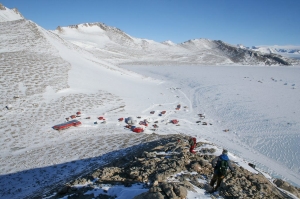Did you know that many countries have research stations in Antarctica?
Antarctica is a continent with no permanent residents, but many researchers stay for short or long periods at one of the 75 research stations that have been established in Antarctica.
 The Norwegian research station Troll in Dronning Maud Land. Photo: Stein Tronstad / Norwegian Polar Institute
The Norwegian research station Troll in Dronning Maud Land. Photo: Stein Tronstad / Norwegian Polar Institute
The Antarctic Treaty stipulates that Antarctica is a continent dedicated to peace and research. Seven nations have made claims in Antarctica, but about 30 of the countries that have signed the Antarctic Treaty send personnel to research stations on the Antarctic continent and the Antarctic Peninsula. All told, there are as many as 45 year-round stations and 30 summer stations (field stations). Norway has one year-round station, Troll, and one field station, Tor, both located in Dronning Maud Land. During the summer season, Antarctica can host nearly 4000 people in and around the various research stations.
Antarctica is a long way to travel. There is one permanent harbour at McMurdo station, but that is on the far side of the continent from Troll station. Ships carrying gear destined for Troll moor at the ice edge in Dronning Maud Land, and the cargo is transported with tracked vehicles from the coast up to Troll. It is possible to fly down to Antarctica, and approximately 20 airstrips have been established. Not far from the Norwegian station Troll lies Troll Airfield, which is used for transportation of personnel and equipment in conjunction with research in the area. This airstrip is part of an air network that also includes Cape Town in South Africa and the Russian research station Novolazarevskaya, northeast of Troll.
There are good reasons that so much research is done in Antarctica. Antarctica has the cleanest air in the world, and atmospheric monitoring is done here to provide neutral data sets. Antarctica is the land area where polar night lasts longest; when combined with extremely dry, thin, clear air, a unique geographic situation with the celestial south pole in zenith, low temperatures, and minimal background radiation, it is obvious why Antarctica has been such a success as an observatory for astronomy, astrophysics, and related disciplines. Studies of the lowest echelons of the food chain give researchers insight into environmental impact on humans. Last but not least, Antarctica has no national borders, which means that the entire continent is open for research.